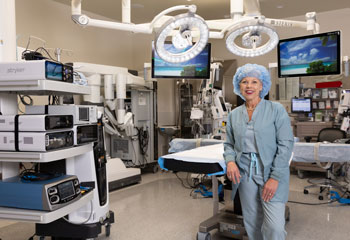
Prostatectomy
If you have prostate cancer, your doctor will usually remove the whole gland to prevent the disease from spreading. It’s called a radical prostatectomy.
Our approach to prostatectomy
When we're talking about prostate cancer, the idea that there's one treatment that fits everybody is not correct. Some of the information you might come across when researching online can be overwhelming.
One of the hallmarks of our approach to care is to determine what your best individual treatment option is. We educate you about prostate cancer with accurate and leading-edge information.
We recommend using the PSA blood test as the primary method to assess your risk of prostate cancer. It can be easily bundled in with your annual blood work and is a valuable early detection tool. Early detection is the key to a higher survival rate and the chance for a full cure.
Every man over 50 should get a yearly PSA blood test, but it should be done even earlier if:
- You have a family history of prostate cancer
- You are of African American descent
- You have a history of certain genetic predispositions to cancer such as the presence of the BRCA gene
If you’re in these high risk groups, start getting screened at 40.
How to work with us
If your primary care doctor is with UCI Health and your blood work causes concern, they’ll recommend you to our urology program. If you have an elevated PSA, then one of our urologists can determine whether you need further testing or a biopsy. We offer the latest in diagnostic tests such as a noninvasive imaging technique called multiparametric MRI.
We also offer a safer and more accurate prostate biopsy that fuses MRI with live ultrasound to better target suspicious areas. Our biopsies are also safer as we utilize a transperineal approach that prevents infection and bleeding.
Or, you may have already received a prostate cancer diagnosis somewhere else and are seeking the best treatment options. You can always contact us directly at the UCI Health Urologic Cancer Program. Speak with one of our fellowship-trained urologic oncologists for an evaluation or a second opinion.
Your team and how they work together
Urologic oncologists are urologists who specialize in urologic cancers. They are likely to be the first practitioner you meet for an evaluation, and they perform minimally invasive robotic radical prostatectomy. A radical prostatectomy removes the whole prostate gland to remove the cancer.
They can also discuss in detail other potential treatment options like active surveillance, focal therapy, radiation therapy, hormonal therapy and chemotherapy. UCI Health medical oncologists handle chemotherapy for prostate cancer. Our radiation oncologists may work with you if radiation is part of your treatment plan.
All our providers work as a team and offer a multidisciplinary prostate cancer clinic. The benefit of our multidisciplinary approach is that it gives you nearly instant access to experts in each subspecialty. If you’re a new UCI Health patient, each subspecialist can meet with you on the same clinic visit for truly team-based care.
Frequently asked questions
Do you need a catheter after prostate removal?
Yes, immediately following prostatectomy, you’ll be discharged from the hospital with a catheter and a small collection bag that is emptied periodically. One week later, we’ll remove the catheter in the office.
Can a prostatectomy cause urinary function changes?
As men age, the prostate gradually enlarges and very often causes bothersome urination changes. Removal of the prostate can actually improve those symptoms for men with pre-existing bother symptoms.
However, urinary leakage is also a common consequence of the surgery. Your surgeon’s experience level plays a very important role in improving urinary control results.
When an experienced surgeon performs a nerve-sparing procedure, permanent severe incontinence after robot-assisted prostatectomy is extremely rare. Our team has performed extensive research to examine and optimize urinary control and has carefully modified the technique over several years. The large majority of men recover urinary control quite well after surgery.
Can a prostatectomy cause ED?
It is technically possible for prostatectomy to cause erectile dysfunction. However, our Urologic Cancer Program doctors have some of the most extensive experience in the world using pioneering nerve-sparing techniques.
During surgery, our doctors use an extraordinary level of precision. They push the nerves involved in sexual function out of the way while still removing the prostate and prostate cancer. This nerve-sparing technique helps you retain erection function.
Dr. David I. Lee, director of the Urologic Cancer Program, has performed thousands of robot-assisted prostatectomies using this nerve sparing technique. This high volume of experience directly optimizes outcomes.
What is life expectancy after prostate removal?
Robotic prostatectomy offers men the highest cure rate for prostate cancer. Once we perform prostatectomy, the vast majority of men will not pass from prostate cancer.
Life expectancy after prostate removal can be 20 years or more if you are otherwise healthy. However, the stage and grade of cancer and your overall health will affect life expectancy. Discussing these details with your doctor will give you the most accurate picture.
Which is better: prostatectomy or radiation?
Fortunately, both options are excellent. However, your current status can provide guidance as to which option may be more favorable. You may find that a combination of treatments work best, but you and your doctor will discover together what’s appropriate.

A prostatectomy doesn’t have to mean loss of a personal life
One of the most prolific urologic oncologist surgeons in the world performs prostatectomies at UCI Health. Partner with us for excellent care. Call 714-456-6068 to speak with a prostate cancer specialist.
Benefits of prostatectomy
A prostatectomy removes the prostate and the prostate cancer within the gland. The cure rates from surgery are the highest among the different treatment options.
Before robotic surgery existed, doctors made a large incision in the lower abdomen that caused pain and was subject to wound infections. In what is now a minimally invasive procedure, we make a few small incisions elsewhere the size of a dime. This greatly reduces the risk of infection and allows for a much faster recovery time.
We routinely send patients home the same day after robotic prostatectomy and have extensively studied the safety of this approach. The nerve-sparing techniques our surgeons use also give you the best possible chance of regaining sexual function and continence.
What to expect
After your tests, you and your doctor will choose a personalized treatment plan. It might include radiation or chemotherapy in addition to surgery.
About the robot-assisted procedure
Before surgery, doctors will give you a general anesthetic. Our surgeons have pioneered the use of a robotically administered TAP block, a process of injecting anesthesia into abdominal muscles. This blocks nerves from sending any pain signals and helps control pain after your surgery.
Our urologists are highly experienced at using the da Vinci Surgical System®, operating robotic arms at a remote console with extraordinary precision. They can see the surgical field in magnified, three-dimensional detail.
After making several very tiny abdominal incisions, your surgeon inserts small tubes called ports. The ports create a channel for surgical tools and an imaging device. The surgeon controls the robotic arms to remove your prostate and seminal vesicles. He or she ensures the cancer is gone and then sutures the incisions.
What happens after my prostatectomy?
You’ll receive both a TAP block and general anesthesia before surgery. What happens after your prostatectomy is that 95% of you will go home the same day.
For about a week after surgery, you’ll wear a catheter to drain your urine into a bag. You’ll empty that small external collection bag as needed. Once we remove the catheter, you’ll likely leak urine for a period of time.
You’ll be able to return to work in two weeks and resume more vigorous activities in about three to four weeks.
Regaining function
You will likely regain full sexual function as part of your long-term healing process. If you had good erectile function before surgery, you have a good chance for full recovery.
Although less likely, if your erectile or urinary function is impacted, our specialists can help with other surgical therapies.
Why choose UCI Health for prostatectomy?
Our Urologic Cancer Program director is one of the top three most experienced prostate cancer surgeons in the world
No two cases are alike. Because of the finely tuned precision needed for a successful surgery, a high volume of patient experience is invaluable.
Dr. David I. Lee has performed over 7,000 prostatectomies, making him an incredibly experienced and knowledgeable clinician. For perspective, there are only eight surgeons worldwide who have done more than 5,000 cases.
To help provide you with even better outcomes, we engage in innovative clinical trials
As an academic medical center, we have the infrastructure and curiosity to engage in ongoing research and clinical trials. For example, we’re mapping all of the very small arteries that feed the prostate. Then we’re using a fluorescent dye to help us better identify these vessels during surgery, further increasing our precision.
We routinely engage in other trials for radiation and chemotherapy. If you qualify for a clinical trial, you may get access to tools, techniques or medicines not widely available. Your participation also greatly helps future patients.
Our multidisciplinary cancer teams are superb
With early detection, a urologist can most likely handle your case. If you have a more aggressive disease or we don’t catch it as early, a multimodal approach is important for thorough care. That would include a urologic surgeon, medical oncologist and radiation oncologist, all highly trained through residencies and coveted fellowships.
Radiation and chemotherapy are also powerful treatment options and could be the primary choice for some. But regardless of your treatment, you have easy access to multiple specialists who can streamline and expedite your healing process.
Featured Blog Posts

Gastric cancer survivor credits novel clinical trial therapy

'Get your mammogram,' urges breast cancer survivor
Annual screenings can detect breast cancer early, when it is most treatable, says UCI Health breast cancer survivor Barbara Cortez.





